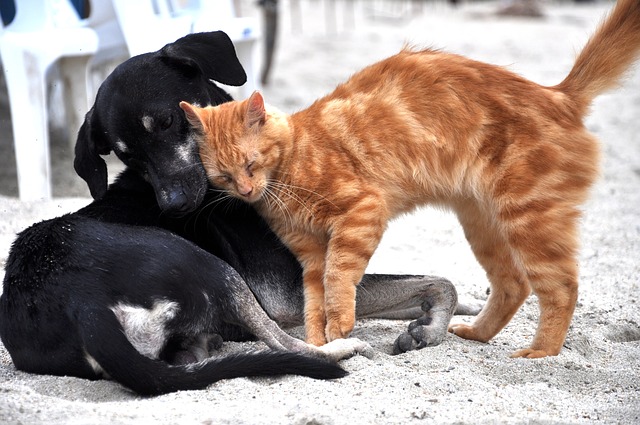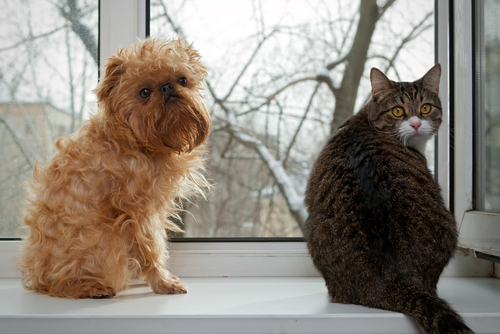There are dog people and there are cat people. Then there are the animal lovers willing to open their homes to any creature in need. Sooner or later, these kindhearted folks find themselves introducing canine and feline pack members – with varying degrees of success. Luckily, there are several factors that can help you determine if your dog is cat-friendly enough for a feline companion before you make the introduction.

Breed
While you absolutely cannot judge a dog based solely on its pedigree, members of certain breed groups are more likely to get along with cats than others. Dogs from the Toy Group such as Maltese, Pugs and Cavalier King Charles Spaniels were bred as loving companions. They tend to be affectionate, sociable and welcoming to new friends – including cats.
Golden Retrievers and Labrador Retrievers are members of the Sporting Group, and are typically friendly and outgoing with everyone and everything. They are also known for their trainability and desire to please their masters.
On the other hand, Terriers, sighthounds, and certain members of the Working Group have high prey drives and an innate desire to chase anything small and fast-moving. These dogs, including Huskies, Jack Russell Terriers, and Greyhounds, were bred to hunt, chase and kill their targets.
However, their hunting skills are just one aspect of their personalities, and certainly do not mean these dogs cannot be friendly with cats. They may need a little extra training and supervision, but all dogs have the potential to be cat-friendly.

Personality
Whether you have a purebred or a mixed-breed, overall personality should give you an idea if a dog is cat-friendly or not. For example, how does your dog behave when the doorbell rings? How about when a squirrel or neighborhood cat crosses his path during a walk?
Since hyper-reactive dogs are more likely to chase and/or attack smaller animals, the way a dog behaves in these situations can provide insight into how they would respond to a cat in the home. Watch for tell-tale body language signals such as stiff posture, staring and lunging.
A 2017 study found that dogs react more strongly to cat sounds as opposed to the sight or smell of a cat. So, if you would like to bring a cat into your home, play your dog a few recordings of feline vocalizations. According to the study, the faster they orient to the sound, the greater the chance the dog is cat-friendly.

Past Behavior
Dr. Phil often says, “the best predictor of future behavior is past behavior.” While he is typically talking about cheating spouses, the same mantra holds true for dogs. Natasha Feduik, a licensed veterinary technician at Garden City Park Animal Hospital in New York, agrees.
“No matter how desperate those puppy eyes are, trust that history will repeat itself,” she writes. “If the dog has gone after a cat or other small animal in the past, he most likely will again.”
Dogs are more likely to be accepting of cats if they are raised among them. If you know you want to have both species, consider bringing them into your home at the same time. This will help prevent territoriality and encourage a mutual bond.
However, just because a dog is cat-friendly with his “own” feline, does not mean he won’t chase others. So always keep your dog on a leash or in a fenced yard.

“Cat-Testing” A Dog
Have you ever wondered how animal shelters determine if a dog is cat-friendly? The process typically involves a couple of experienced staff members and one very laid back cat! Most shelters and rescue groups have a special cat or two that are perfectly comfortable in the company of dogs. These friendly felines serve as their official “cat testers.”
The test begins with the cat in a crate or safely behind a glass door while the dog walks past on a leash. If the dog remains calm with a healthy level of curiosity, the volunteer takes the cat out of the crate and holds it in his or her arms. While it is perfectly normal for the dog to sniff and examine the cat, the staff watch for concerning behaviors such as those listed above.

If there is no barking or lunging, the next step is to put the cat on the floor with the dog still safely on a leash. Should the dog maintain his or her manners, the very last step is to let go of the leash and allow the dog to examine the cat face-to-face.
This is a surefire method for determining if a dog is cat-friendly and ready to make feline friends. However, only professionals should attempt to perform a cat-test. Contact a trainer or behaviorist to help you determine your dog’s level of comfort with cats.
Canines and felines can certainly coexist peacefully, but it may take a bit of an adjustment period. Remember, animals are individuals, just like humans. Regardless of your dog’s breed, personality, or past behavior, it is always best to closely monitor the early interactions between dogs and cats.
H/T to AKC.org, PetMD & BestFriends.org
 Toledo, United States.
Toledo, United States.